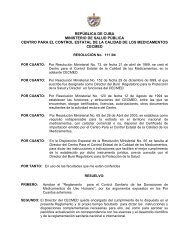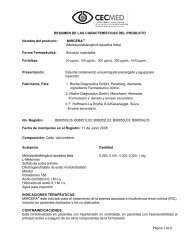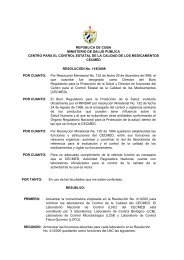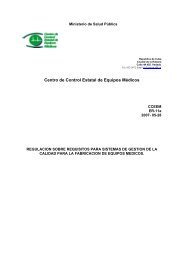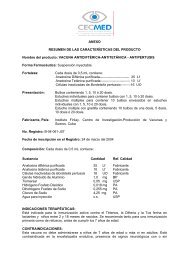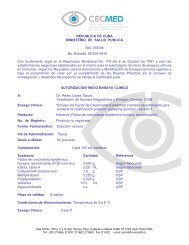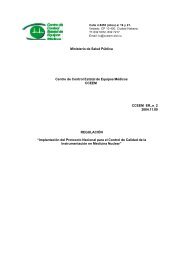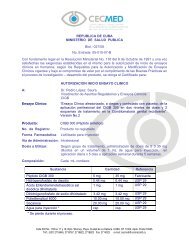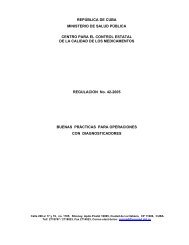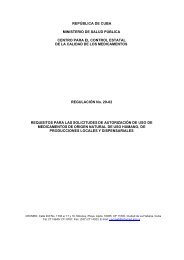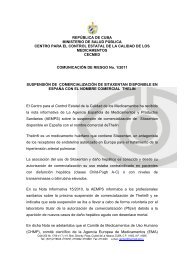AC 2005 Vol-1.pdf - Cecmed - Infomed
AC 2005 Vol-1.pdf - Cecmed - Infomed
AC 2005 Vol-1.pdf - Cecmed - Infomed
You also want an ePaper? Increase the reach of your titles
YUMPU automatically turns print PDFs into web optimized ePapers that Google loves.
30<br />
Mecanismos de acción...<br />
célula, de esta forma, el anillo del óxido de<br />
etileno se abre y se une a los grupos<br />
carboxilos, aminos, sulfidrilos y oxhidrilos<br />
de las proteinas, además, reaccionan con el<br />
ADN y el ARN, posiblemente por<br />
esterificación de los grupos fosfatos o por<br />
reacción con el anillo nitrogenado de las<br />
purinas y pirimidinas [14].<br />
Finalmente, está claro que los<br />
microorganismos pueden adaptarse a una<br />
gran variedad de condiciones físicas y<br />
químicas, es por ello que no es una<br />
sorpresa la resistencia que se reporta<br />
actualmente a los diferentes agentes<br />
químicos. Es de señalar la importancia que<br />
tiene, además, una correcta selección de<br />
los agentes químicos cuando se van a<br />
emplear frente a las células microbianas,<br />
lo cual se asocia con una mayor eficiencia<br />
en el uso de estos, siempre y cuando se<br />
roten para impedir que se generen<br />
mecanismos de resistencia que influyan<br />
sobre el modo de acción de los agentes<br />
químicos.<br />
Referencias Bibliográficas<br />
[1] Denyer, S.P,1995. Mechanisms of action of<br />
antibacterial biocides. Int. Biodeterior,<br />
Biodegrad 36: 227-245<br />
[2] Klingeren, B, 1995. Disinfectant testing on<br />
surfaces. : J-Hosp-Infect. 1995 Jun; 30 Suppl:<br />
397-408<br />
[3] 8-Teixeira,P, 1996. Biosseguranca. Uma<br />
Abordagem Multidisciplinar.<br />
[4] Emori, T.G. & Gaynes,R.P.,1993. An overview<br />
of nosocomial infections, including the role of<br />
the microbiology laboratory. Clinical<br />
Microbiology Reviews,<br />
[5] Hugo,H.B.,1982. Historical introduction. In:<br />
Russell, A.D., Hugo, H.B and Ayliffe, G.A.<br />
Principles and practice of disinfection,<br />
preservation and sterilization. Oxford:<br />
Blackwell.,653 p.8-106<br />
[6] Block S.S, 1991. Historical review. In:<br />
Block,S.S. Disinfection, sterilization and<br />
preservation, 4th Ed Philadelphia: Lea &<br />
Febiger. 1162p. 3-17.<br />
[7] Kahrs RF, 1995. General disinfection<br />
guidelines.Rev-Sci-Tech. 1995 Mar; 14(1): 105-<br />
63<br />
[8] Wilson JD, 1995. Use of desinfectants in<br />
parenteral facilities. PDA, México<br />
[9] Jeffrey DJ, 1995. Chemicals used as<br />
disinfectants: active ingredients and enhancing<br />
additives. Rev-Sci-Tech. 1995 Mar; 14(1): 57-74<br />
[10] Russell, A.D., 1982. Factors influencing the<br />
efficacy of antimicrobial agents. In: Russell,<br />
A.D., Hugo, H.B. and Ayliffe, G.A.J. Principles<br />
and practice of disinfection, preservation and<br />
sterilization. Oxford: Blackwell. 653p.107-133<br />
[11] Rutala, W.A., 1987. Disinfection, sterilization<br />
and waste disposal. In: Wenzel R.P. Prevention<br />
and control of nosocomial infections. Baltimore:<br />
Williams & Wilkins.641 p.247-282.<br />
[12] Prince, H.N.,1983. Disinfectant activity against<br />
bacteria and viruses: a hospital guide. Particulate<br />
& Microbial Control Mar/Apr.<br />
[13] Favero, M.S & Bond, 1991. Chemical<br />
disinfection of medical and surgical materials.<br />
In: Block, S.S Disinfection, sterilization and<br />
preservation. 4th Ed Philadelphia: Lea &<br />
Febiger. 1162p. 617-64.<br />
[14] Gardner, J.F & Peel, M.M.,1991. Introduction to<br />
sterilization, disinfection and infection control.<br />
2ed. Melbourne: Churchill Livingtone, 264 p.<br />
Recibido: 10 de septiembre de 2004<br />
Aceptado: 20 de diciembre de 2004




